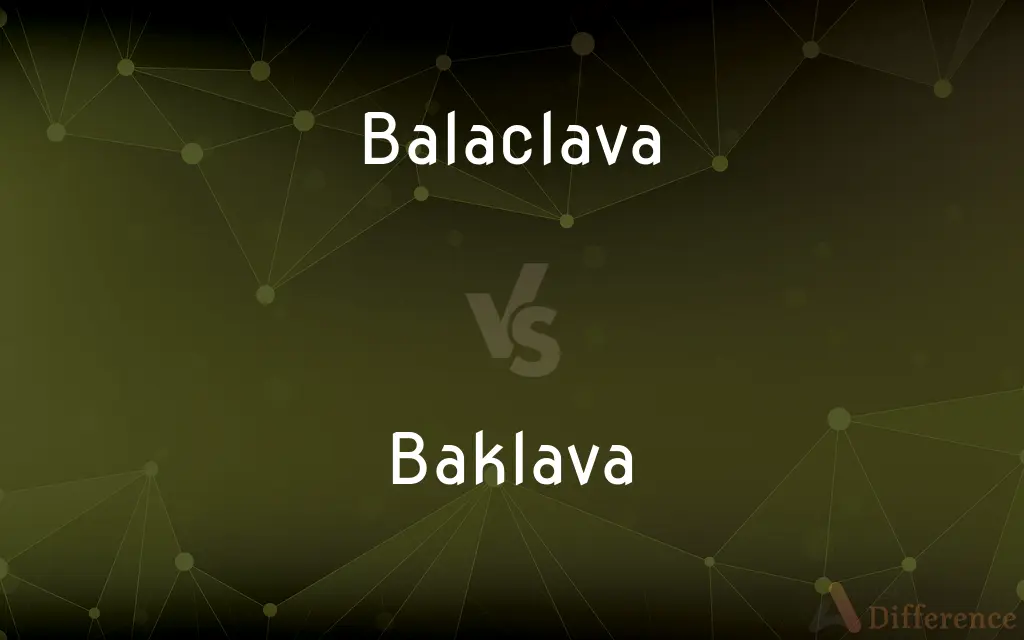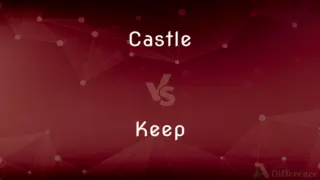Balaclava vs. Baklava — What's the Difference?
Edited by Tayyaba Rehman — By Fiza Rafique — Updated on April 7, 2024
A balaclava is a form of headgear designed to expose only part of the face, whereas baklava is a sweet dessert made of layers of filo pastry.

Difference Between Balaclava and Baklava
Table of Contents
ADVERTISEMENT
Key Differences
Balaclavas are head coverings that provide warmth and concealment, covering the entire head and neck but leaving parts of the face exposed, typically the eyes and mouth. They are often used in cold climates or as part of military and tactical gear. On the other hand, baklava is a rich, sweet pastry made of layers of filo filled with chopped nuts and sweetened with syrup or honey. It is a popular dessert in Middle Eastern and Balkan cuisines.
While balaclavas are made from materials like wool, cotton, or synthetic fabrics to provide insulation or protection, baklava's ingredients include filo pastry, nuts like walnuts, pistachios, or almonds, and sweeteners like honey or sugar syrup. Balaclavas serve a functional purpose in protecting the wearer from the elements or concealing their identity, whereas baklava is a treat enjoyed for its sweet, crunchy, and nutty flavors.
Balaclavas have variations in design, such as those with multiple openings for the eyes and mouth or convertible styles that can be pulled down to expose the face. Conversely, baklava has various regional recipes that alter the type of nuts used, the composition of the syrup, and the layering technique, reflecting the diverse culinary traditions of the regions where it is popular.
The choice between wearing a balaclava or consuming baklava hinges on the context: one addresses physical comfort and protection in harsh conditions or for privacy, while the other caters to the palate, offering a sensory experience of sweetness and texture. Despite the phonetic similarity in their names, balaclavas and baklava occupy entirely different categories of human need and pleasure, illustrating the vast diversity of objects and experiences that language can describe.
In terms of social and cultural significance, balaclavas can be symbolic of anonymity, rebellion, or solidarity in certain contexts, such as protests or military operations. Baklava, however, represents hospitality, celebration, and the sharing of sweet moments among friends and family, especially during festive occasions.
ADVERTISEMENT
Comparison Chart
Type
Headgear
Dessert
Material/Ingredients
Wool, cotton, synthetic fabrics
Filo pastry, nuts, honey/syrup
Purpose
Warmth, concealment
Culinary enjoyment
Variations
Different openings, styles
Regional recipes, nut types
Cultural Significance
Anonymity, rebellion, protection
Hospitality, celebration
Compare with Definitions
Balaclava
Cultural Symbol.
In some cultures, a balaclava can symbolize protest or dissent.
Baklava
Variety of Nuts.
The baklava was filled with a rich mix of pistachios and walnuts.
Balaclava
Headgear for Cold Weather.
He wore a balaclava to keep warm during the winter hike.
Baklava
Celebratory Dessert.
At the wedding, they celebrated with traditional baklava.
Balaclava
Tactical Equipment.
The special forces team donned balaclavas to conceal their identities.
Baklava
Middle Eastern Origin.
Baklava is considered a delicacy in Middle Eastern cuisine.
Balaclava
Protection from Elements.
She pulled her balaclava tighter to protect against the biting wind.
Baklava
Sweet Pastry.
For dessert, they served baklava with a drizzle of honey.
Balaclava
Variety of Styles.
His balaclava had an opening just for the eyes, optimizing warmth.
Baklava
Made with Filo Dough.
She layered the filo dough carefully to make homemade baklava.
Balaclava
A knitted cap covering the head and neck with an opening for the eyes or face, used as cold-weather gear especially by soldiers, mountain climbers, and skiers.
Baklava
Baklava (, or ; Ottoman Turkish: باقلوا) is a layered pastry dessert made of filo pastry, filled with chopped nuts, and sweetened with syrup or honey. It was one of the most popular sweet pastries of Ottoman cuisine.The pre-Ottoman origin of the dish is unknown, but, in modern times, it is a common dessert of Iranian, Turkish and Arab cuisines, and other countries of the Levant and Maghreb, along with the South Caucasus, Balkans, and Central Asia.
Balaclava
A type of warm headgear covering the neck, head, and often part of the face, with apertures left as necessary, often made out of wool.
Baklava
A dessert made of paper-thin layers of pastry, chopped nuts, and honey.
Balaclava
A ski mask with holes for the eyes and, sometimes, the nose and mouth, which may be rolled up and worn like a toque or pulled over the face for greater protection.
Baklava
A popular sweet pastry found in many cuisines of the Middle East and the Balkans, made of chopped nuts layered with phyllo pastry. since c. 1650; modern spelling since 1800s
Balaclava
Close-fitting and woolen and covers all of the head but the face.
Baklava
Rich Middle Eastern cake made of thin layers of flaky pastry filled with nuts and honey
Balaclava
A cap that is close-fitting and woolen and covers all of the head but the face
Common Curiosities
How is baklava made?
By layering thin sheets of filo dough with chopped nuts and baking, then soaking it in syrup or honey.
What is a balaclava?
A headgear covering most of the head and neck, leaving part of the face exposed.
Can balaclavas be worn in warm weather?
While designed for cold weather, lightweight versions exist for sun protection or concealment in warmer climates.
Is baklava served hot or cold?
It can be enjoyed either way but is commonly served at room temperature.
Are there different styles of balaclavas?
Yes, including those with various openings for eyes/mouth and convertible styles.
What nuts are used in baklava?
Commonly walnuts, pistachios, or almonds.
Can baklava be made without nuts?
Traditional recipes include nuts, but variations without nuts exist for those with allergies.
What is baklava?
A sweet dessert made of layers of filo pastry, filled with nuts and sweetened with syrup or honey.
Is balaclava one size fits all?
Most are designed to stretch and fit different head sizes, but sizes can vary.
How do you store baklava?
In an airtight container at room temperature or refrigerated to extend freshness.
Is a balaclava a military item?
It has military uses but is also popular for civilian activities like skiing or motorcycling.
Why wear a balaclava instead of a scarf?
Balaclavas provide more comprehensive coverage and can be more secure in windy conditions.
Is homemade baklava difficult to make?
It requires patience and skill, especially in handling the delicate filo dough, but is achievable with practice.
What occasions is baklava typically served for?
It's popular during celebrations, holidays, and as a treat in many Middle Eastern and Mediterranean cultures.
Do balaclavas come in different materials?
Yes, including wool, cotton, synthetic fibers, and silk for various climates and needs.
Share Your Discovery

Previous Comparison
Castle vs. Keep
Next Comparison
Agar vs. CarrageenanAuthor Spotlight
Written by
Fiza RafiqueFiza Rafique is a skilled content writer at AskDifference.com, where she meticulously refines and enhances written pieces. Drawing from her vast editorial expertise, Fiza ensures clarity, accuracy, and precision in every article. Passionate about language, she continually seeks to elevate the quality of content for readers worldwide.
Edited by
Tayyaba RehmanTayyaba Rehman is a distinguished writer, currently serving as a primary contributor to askdifference.com. As a researcher in semantics and etymology, Tayyaba's passion for the complexity of languages and their distinctions has found a perfect home on the platform. Tayyaba delves into the intricacies of language, distinguishing between commonly confused words and phrases, thereby providing clarity for readers worldwide.
















































